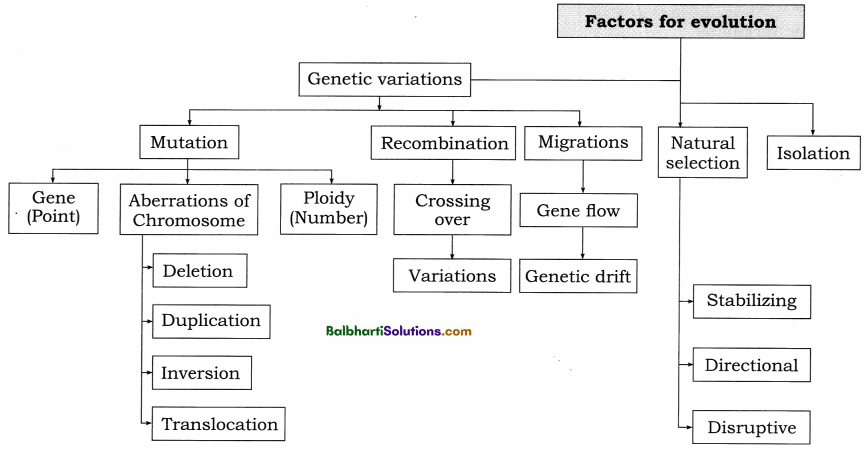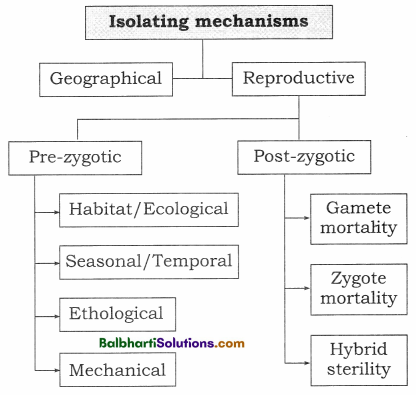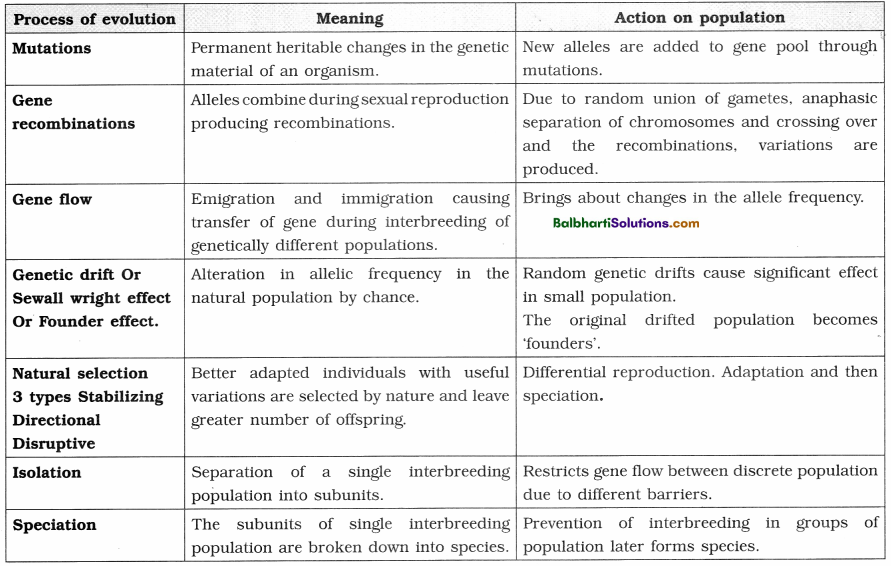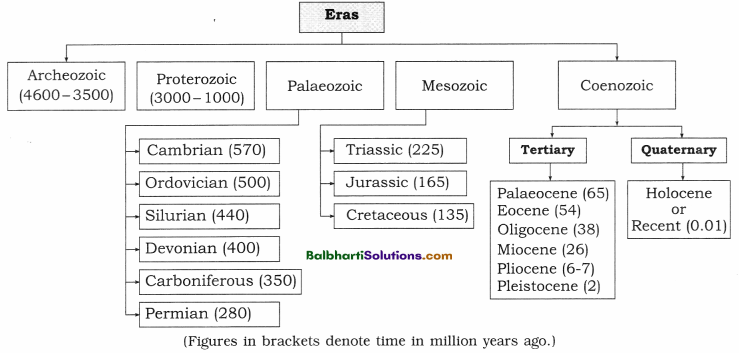By going through these Maharashtra State Board 12th Science Biology Notes Chapter 5 Origin and Evolution of Life students can recall all the concepts quickly.
Maharashtra State Board 12th Biology Notes Chapter 5 Origin and Evolution of Life
Origin of life (Protobiogenesis)-
1. Attributes of living organisms : Responsiveness, growth, metabolism, energy transformations and reproduction.
2. Various theories and hypotheses to propose origin of life :
| Name of the theory | Characteristic point | What does the theory say? |
| Theory of special creation | Oldest theory. No scientific proof. Only religious beliefs. | All living organisms are created by a supernatural power. |
| Cosmozoic theory/Theory of Panspermia | NASA has reported fossils of bacterialike organisms on a piece of Martian rock recovered from Antarctica. | Life descended to the earth from other planets in the form of cosmozoa/panspermia. |
| Theory of spontaneous generation (Abiogenesis) | Disproved by Louis Pasteur. | Life originated from non-living material |
| Theory of biogenesis | Explains only the continuity of life. | Living organisms produced from pre-existing living forms, by process called reproduction. |
Chemical Evolution of Life (Self-assembly theory of origin of life)-
1. Theory of biochemical origin of life : Life originated on earth by combinations of several chemicals through constant chemical reactions over a long period of time.
Formulated by Haeckel, developed by Alexander I. Oparin (1924) and J. B. S. Haldane (1929).
2. The steps in the process of chemical evolution :
- Origin of Earth and Primitive atmosphere : Big-Bang theory of Georges Lemaitre (1931). Formation of reducing atmosphere.
- Formation of ammonia, water and methane : Formation of CH4, NH3, H2O and H2S.
- Formation of simple organic molecules : Formation of monosaccharides, amino acids, purines, pyrimidines, fatty acids, glycerol, etc. Formation of water bodies resulting into ‘hot dilute soup’ or ‘primitive broth’.
- Formation of complex organic molecules : Formation of complex organic molecules like polysaccharides, fats, proteins, nucleosides and nucleotides. Protoproteins → proteins.
Formation of protein molecules : Landmark in the origin of life. - Formation of Nucleic acids : Formation of Nucleotides→nucleic acids (RNA, DNA) →acquired self-replicating ability→ fundamental property of living form.
- Formation of Protobionts or Procells : First form of life called protobionts was formed from nucleic acids by coacervation.
Protobionts : Prebiotic chemical aggregates having some properties of living system.
Protobionts also called Coacervates (Oparin) and protenoids or microspheres (Sidney Fox)
Coacervates and microspheres were non¬living colloidal aggregations of lipids and proteinoids respectively. They turned into eobionts or protocell.
Showed growth and division and hence considered as first primitive living system.
- Formation of first cell : First cell developed by formation of RNA and DNA system. First cell was anaerobic, heterotrophic and obtained energy by chemoheterotrophic processes.
Stanley L. Miller and Harold C. Urey provided the first experimental evidence for Oparin’s chemical evolution theory.
![]()
3. RNA World Hypothesis :
- First proposed by Carl Woese, Francis Crick and Leslie Orgel in 1960.
- Sidney Altman and Thomas Cech independently found out that RNA can also act as biocatalyst which is termed as Ribozyme.
- Early life must have been based exclusively on nucleic acids, most probably RNA.
Organic Evolution-
- Evolution (Latin word, e = from; volvere = to roll) : The act of unrolling or unfolding of nature.
- Organic evolution : Slow, gradual, continuous and irreversible changes through which the present-day complex forms of the life developed (or evolved) from their simple pre¬existing forms.
- Charles Darwin’s definition of evolution :
‘Descent with modification’. - Lamarck’s theory (Theory of origin of acquired characters/inheritance of acquired characters and use and disuse of organs) : The traits are acquired due to internal force, changes in environment, new needs and the use and disuse of organs. This gives rise to new species after several generations. Lamarckism was disproved by August Weismann.
- Weismann’s theory of Germplasm : Variations produced in somatic cells (somatoplasm) are not inherited while variations produced in germ cells (germplasm) are inherited to next generation.
Darwinism-
1. Darwinism or theory of origin of species by Natural Selection.
2. Darwin’s book : ‘The origin of species by Natural Selection’, wrote in 1859 after observations of variations between the tortoises and finches on Galapagos islands.
3. C. Lyell’s viewpoint on which Darwin’s theory was based : The natural forces that existed in the past are same as those existing at present.
4. Wallace also made similar observations.
5. R. Malthus provided the idea that increase in human population leads to competition and struggle for existence of human species.
6. Five main postulates of Darwinism :
- Overproduction (Prodigality of nature)
- Struggle for existence
- Organic variations
- Natural selection (H. Spencer termed natural selection as ‘survival of fittest’)
- Origin of new species
7. Evidences Darwinism include :
- Evolution of long-necked Giraffe came to existence.
- Black colour peppered moths evolved gradually as new species.
- DDT resistance
8. Drawbacks and Objections to Darwnism :
- Darwin wrongly considered minute non- heritable fluctuating variation as principal factors. They do not form part of evolution.
- He did not distinguish somatic and germinal variation and considered all variations are heritable.
- He did not explain the ‘arrival of the fittest’. He did not explain the cause, origin and inheritance of variations and of vestigial organs.
- He could not explain the extinction of species.
- Intermediate form during evolution were not recognised.
- He could not explain existence of neutral flowers and the sterility of hybrids.
Mutation Theory-
1. Hugo de Vries proposed mutation theory based on his observations on Oenothera lamarckiana.
2. Though offspring resemble their parents in many characters, some sudden and spontaneous variations are seen in them, which is said to be mutations or discontinuous variations.
3. Main features of mutation theory :
- Large, sudden and discontinuous variations, inheritable changes in a population which provide the raw material for organic evolution.
- Mutation may be useful or harmful. Useful mutations are selected by nature.
- Accumulation of useful mutations over a period of time leads to the origin and establishment of new species, while harmful mutations are eliminated by nature or can remain in population.
4. Objections to Mutation Theory :
- The large and discontinuous variations were chromosomal aberrations which bring about minor changes.
- Rate of mutation is very slow.
- Chromosomal aberrations are unstable and hence not important in evolution.
5. Speciation (Formation of new species) :
- Small Darwinian variations are directional. Variations due to mutations are large, sudden, random.
- Darwin’s opinion : Gradual, inheritable variations over a long period of time, lead to speciation.
- De Vries’s opinion : Mutations cause speciation.
- Saltation : A single step large mutation.
Modern Synthetic Theory of Evolution-
- R. Fischer, J. B. S. Haldane, T. Dobzhansky, J. Huxley, E. Mayr, Simpson, Stebbins, Fisher, Sewall Wright, Medel, T. H. Morgan, etc. together have synthesised the modern theory of evolution.
- Stebbins suggested five key factors for evolution : Gene mutations, chromosomal mutations, genetic recombinations, natural selection and reproductive isolation → together bring about evolution of new species.
- Population : All individuals of the same species form population.
- ‘Mendelian population’ : Small groups of interbreeding populations.
- Gene pool : Gene pool is the total genetic information or sum total of genes of all individuals in a Mendelian population.
- Factors affecting gene pool : Migration, replacement of one generation by another in the Mendelian population.
- Gene frequency : The proportion of an allele in the gene pool, to the total number of alleles at a given locus.
- Factors of Modern synthesis theory:

- Gene Mutation : Sudden permanent heritable change in the genetic material is called mutation. Single gene mutations are called point mutations. Chromosomal aberrations and ploidy too cause mutations. All mutations lead to variations.
- Genetic recombination : Crossing over in sexually reproducing organisms cause variations , during gamete formation. Crossing over also create recombination.
Crossing over : Exchange of genetic material occurs between non-sister chromatids of homologous chromosomes. - Gene flow : Movement of genes into or out of a population. Migration of organism, or gametes (dispersal of pollens) or segments of DNA (transformation).
- Genetic drift : Any random fluctuation (alteration) in allele frequency, occurring in the natural population by pure chance. Smaller populations may show genetic drift.
- Chromosomal aberrations : The structural, morphological change in chromosome due to rearrangement cause chromosomal aberrations.
Types of aberrations :
- Deletion : Loss of genes from chromosome.
- Duplication : Repetitions of genes or doubling of chromosome number.
- Inversion : Sequence of the genes get inverted due to 180° twist.
- Translocation : Transfer (transposition) of a part of chromosome or a set of genes to a non-homologous chromosome.
Natural selection : Main driving force behind the evolution. It brings about evolutionary changes by favouring differential reproduction of genes that bring about changes in gene frequency from one generation to next generation. The ‘fittest’ (well adapted) survives and leaves more progeny. E.g. Industrial melanism in peppered moth (Biston betularia) is example of natural selection in action.
Isolation : The separation of the population of a particular species into smaller units which prevents interbreeding between them is isolation.
Isolating mechanisms : Barrier which prevents gene flow or exchange of genes between isolated populations.
![]()
Type of isolating mechanisms :

Mechanism of organic evolution-
1. During evolution population evolves and not the individual.
2. Basic processes which bring about evolution : Mutations, gene recombination, gene flow (migration),
genetic drift, natural selection, isolation and speciation.

Hardy-Weinberg’s principle-
Hardy-Weinberg’s equilibrium/principle/law states that ‘at equilibrium point both the gene (allele) frequency and genotypic frequency remain constant from generation to generation’, only in diploid, sexually reproducing, large, free interbreeding population if mating is random and in absence of selection and other evolutionary forces.
Hardy-Weinberg equilibrium equation : p2 + 2pq + q2 = 1
Adaptive Radiation-
Adaptive radiation is the process of evolution which results in transformation of original species to many different varieties. E.g. (1) Darwin’s Finches on Galapagos islands. (2) Australian Marsupials.
Evidences of organic evolution-
Evolutionary evidences are based on following types of disciplines : Palaeontology, comparative anatomy, embryology and molecular biology

Speciation-
- Speciation : The process of formation of a new species from the pre-existing species.
- Species : A group of similar organisms that can interbreed and produce a fertile offspring in nature.
- Types of speciation:

Geological time scale –

Human Evolution-
1. Major changes in evolutionary development of man :
- Increase in size and complexity of brain and enhanced intelligence with increased cranial capacity.
- Bipedal locomotion, erect posture.
- Opposable thumb.
- Shortening of forelimbs and lengthening of hind limbs.
- Development of chin. Orthognathous face.
- Broadening of pelvic girdle, development of lumbar curvature.
- Articulated speech, art, development of tools, social and cultural development.
![]()
2. Classification of mammals:

3. Origin and evolution of human being :
(1) Order Primates is divided into two suborders – Prosimii (including lemurs, lorises : and tarsiers) and Anthropoidea (including : New world monkeys – Ceboidea, Old world monkeys-Cercopithecoidea, Apes and :
Man – Hominoidea).
(2) Hominoidea evolved in Miocene in three • separate lines are shown as under :
- Hyalobatidae – Gibbons
- Pongidae – Gorilla, Chimpanzee and Orangutan
- Hominidae – Primates with human characteristics.
4. Palaeontological evidences of human • evolution : The available fossils are skulls, • mandibles, teeth, bones like humerus, femur and stone implements.
5. Important stages in the origin of man :
- Ape like stage : Dryopithecus
- Men-like stage : Ramapithecus
- Connecting link between ape and man : Australopithecus.
- Handy man : Homo habilis
- Ape man : Homo erectus
- Advanced prehistoric man : Homo : neanderthalensis (Neanderthal man)
- Modern man : Homo sapiens